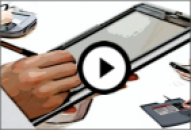Digital Transformations to
Eliminate Your Process Frictions
- Sectors
- Banking
- Investment Management
- Insurance
- Telecoms & Utilities
- Commercial Services
- Healthcare
- Public Sector
- What is Customer Communications Management


 Connect with us on Linkedin
Connect with us on Linkedin 
Call +44 (0)203 823 6535
or click here to arrange a callback
What is Customer Communications Management (a.k.a. “CCM”)?
Gartner (a leading information technology research company) recognises an important technology segment labelled ‘Customer Communications Management’ (“CCM”). Such solutions, also termed ‘Document Output for Customer Communications’ (“DOCCM”) by Forrester, is an emerging market segment for software in large organisations seeking improvements in their communications efficiency, effectiveness and customer satisfaction. The terms refer to new Software types used to compose, format, personalize, and distribute content to support physical and electronic customer communications and improve the customer experience.
It supports many types of content [including letterhead, invoices, correspondence, marketing materials, policies, statements, welcome kits, emails, PDF for web portals, etc.]. Enterprises need this across structured batch print output, human based two-way interactive discussions and resulting documentation, and self-service online "on-demand" transactions. The provision of such flexibility becomes increasingly important and challenging as the size of customer bases increases or is multi-lingual.
For all interaction channels - Customers increasingly demand a choice of paper, interactive and self-serve online
 |
 |
 |
| Structured Print: Central and Local | Interactive: Call Centres, F2F and Mobile | Online and On-Demand: Anywhere |
Servicing multiple channels and tasks with the same degree of accuracy, compliance and brand consistency is currently challenging many large enterprises to provide cost-effective solutions. Examples of use types are client web-based requests to confirm policy details, customer smartphone-based queries, and face-to-face or contact centre generation of printed documents.
Combining CCM systems with enterprise CMS can produce dramatic results when aligned with innovation and process change.
What are Content Management Systems (a.k.a. “CMS”)?
A Content Management System (CMS) is a computer program that allows publishing, editing and modifying and maintaining content, typically for presenting information on websites, from a central software interface. Such systems of content management provide procedures to manage workflow in a collaborative environment. These procedures can be manual steps or an automated cascade.
Background
CMS have been around for much longer than CMM systems, but their capabilities have evolved dramatically in recent years. The first CMS was announced at the end of 1990s - designed to simplify the complex task writing numerous versions of code and to make the website development process more flexible. CMS platforms allow users to centralize data editing, publishing and modification on a single back-end interface. In a CMS, content can be defined as quite widely such as documents, movies, pictures, phone numbers, scientific data, etc.
CMSs are used for storing, controlling, revising, semantically enriching and publishing documentation. Serving as a central repository, the CMS raises the version level when new updates are added to an already existing file. Version control is one primary advantage of a CMS.
Distinguishing between the basic concepts of ‘User’ and ‘Content’, the CMS has two elements:
- Content Management Application (CMA) is the front-end user interface that allows a User, even with limited expertise, to add, modify and remove content from a Web site without the intervention of a Webmaster.
- Content Delivery Application (CDA) compiles that information and updates the Web site.
CMS Types
Most CMS include Web-based publishing, format management, revision control, indexing, search, and retrieval.
With more complex and powerful functions than simple CMS, Enterprise Content Management systems (“ECM”) organise documents and records related to organisational processes. They structure the enterprise's information content and file formats, manage locations, streamline access by eliminating bottlenecks and optimize security and integrity.
There are two notable types of CMS:
(i) A web content management system (“web CMS”) is a bundled or stand-alone application to create, manage, store and deploy content on Web pages. Web content includes text and embedded graphics, photos, video, audio, and code (e.g. for applications) that displays content or interacts with the user. A web CMS may catalogue and index content, select or assemble content at runtime, or deliver content to specific visitors in a requested way, such as other languages. Web CMSs usually allow client control over HTML-based content, files, documents, and web hosting plans based on the system capabilities and the niche it serves.
(ii) A component content management system (“CCMS”) specializes in the creation of documents from component parts (a.k.a. “data fragments”). For example, a CCMS that uses DITA XML enables users to assemble individual component topics into a map (document) structure. These components can be reused (rather than copied and pasted, or manually re-created) within another document or across multiple documents. This ensures that content is consistent across the entire documentation set.
So What?
Whilst an individual CMS may be fit for its specific purpose, large organisations typically deploy many types of CMS. Essential content is spread across live file servers, archive systems, mail archives, paper archives and project-specific team archives. Often there is such a proliferation of content and systems that efficient content re-use is sub-optimal, or worse essential content cannot be found when needed at the point of use in a workflow.
Business processes need tools to support Enterprise Content Integration so automated workflows are not constrained by hidden content, multiple interfaces and formats. An Enterprise Virtual Repository can be created to allow transparency, irrespective of how or where in the organisation the content is stored and managed. With iconuk’s Content Service Platform, content services ensure content is not replicated, merely virtualised, which allows access across different sources via direct and query based exchange.
Notice: Thanks to Wikipedia for some CMS descriptions. You are free to Share [copy, distribute and transmit] or Remix/adapt the work - on this page only of the site. For any reuse or distribution of textual content on this page, the license terms of this work can be found by clicking on the link: http://creativecommons.org/licenses/by-sa/3.0/
